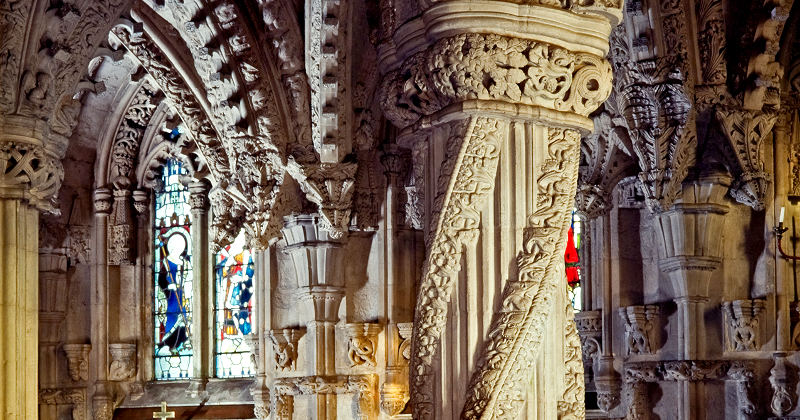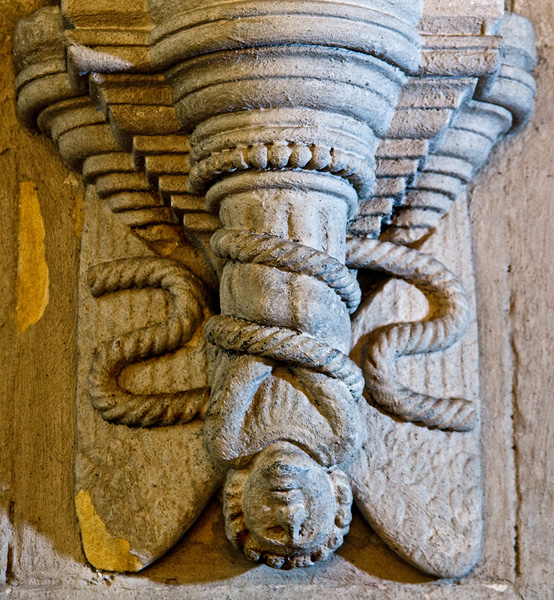Scotland – Apr 13 –15, 2018
ROSSLYN CHAPEL
Arguably Scotland’s most beautiful and enigmatic church, Rosslyn Chapel only reached fame with Dan Brown’s The Da Vinci Code and the subsequent Hollywood film. Since 2003, the number of tourists has ballooned (190,000 in 2017) and this has made possible the financing of the restoration of the church.
The chapel was built in the mid-15th century by William St Clair, the third Earl of Orkney whose home was in Rosslyn Castle. The ornately carved interior – at odds with the architecture of the time – is a monument to the mason’s art, rich in symbolic imagery. As well as flowers, vines, angels and biblical figures, the carved stones include many of the pagan ‘Green Man’ – an ornate face with plants typically coming from its mouth – there are supposedly 100 green men in the church. Other figures are associated with Freemasonry and the Knights Templar. Oddly there are also carvings of plants from the Americas – maize, aloe vera, and – that predate Columbus’ voyage of discovery.
The symbolism of these images has led some researchers to conclude that Rosslyn is some kind of secret Templar repository and it has been claimed that hidden vaults beneath the chapel conceal anything from the Holy Grail or the head of John the Baptist to the body of Christ himself.
The chapel is owned by the Episcopal Church of Scotland and holds regular services. It is on the eastern edge of the village of Rosslyn, 7 miles south of Edinburgh’s center.
The 10£ (7 reduced) covers an excellent hourly talk by a guide. The included brochure also has details of most of the significant carvings.
In the 12th century, King David changed capitals from Dunfermline to Edinburgh. The first effective wall was constructed in 1450, enclosing the Old Town – making it the most populous town in Scotland. Overcrowding resulted in tenements 5 and 6 stories high.
Reformation (1560-1690) was led by the Calvinist firebrand John Knox. Mary, Queen of Scots held court in the Palace of Holyroodhouse for 6 years, but when her son James VI succeeded Elizabeth I to the English throne in 1603, he moved his court to London. The Act of Union in 1707 further reduced Edinburgh’s importance.
Scottish Enlightenment (1740-1830). Cultural and intellectual life flourished and Edinburgh was a hotbed of ‘genius’. In the second half of the 18th century, the New Town was built and in the 19th century, the population quadrupled to 400,000.
In the 1920s, the city’s borders expanded to encompass Leith in the north, Cramond in the west, and the Pentland Hills in the south. Following WWII, cultural life blossomed, stimulated by the Edinburgh International Festival and the Fringe, both held for the first time in 1947 and are now recognized as world-class festivals.
After the 1997 referendum in favour of a Scottish Parliament which first convened in 1999 in the modern building at the foot of the Royal Mile. The 2014 independence referendum saw Scots vote to remain part of the UK but the 2107 Brexit vote disappointingly saw the UK leave the European Union (Scotland voted overwhelming to stay).
OLD TOWN. The Royal Mile extends as its spine between Edinburgh Castle and Holyrood. It descends to the south down Victoria St at Grassmarket as a maze of closes (alleys) and wynds, stairs, and vaults. To the north was Nor’ Loch, now drained and occupied by Princes Street Gardens. Until the founding of New Town, it was overcrowded and unsanitary, forced to expand upwards as the skyscrapers of their day. All classes of society lived cheek by jowl, the wealthy occupying the middle floors – high enough to be above the noise and stink of the streets, but not so high that climbing the stairs would be so tiring – while the poor squeezed into attics, basements, cellars, and vaults amid rats, rubbish and raw sewage.
Edinburgh Castle. Sitting on the most easily defended route between England and central Scotland followed by countless armies from Roman legions to the Jacobite troops in 1745. Pass through the Entrance Gateway and Portucullis gate to the cannons ranged along the battlements with views down to New Town. The One O’Clock Gun, a WWII 25-pounder, fires every day at exactly 1 pm.
Curl south through Foog’s Gate to the highest part of the rock at St Margaret’s Chapel, the oldest surviving building in Edinburgh (1130), and Mons Meg, an 1149 giant siege gun.
The main group of buildings surrounds Crown Square: The Scottish National War Memorial and the Great Hall built for James IV (r 1488-1513) as a ceremonial hall and used as the Scottish Parliament until 1639. Enter the Castle Vaults (used as storerooms, bakeries, and prisons) under the Great Hall via the Prisons of War exhibit. The Royal Palace, on the eastern side of the square, has the strongroom with the crown jewels of Scotland and the Stone of Destiny (a 26.5”x16.5”x11” block of sandstone with rusted iron hoops at both ends had sat for 700 years under the Coronation Chair in Westminster Abbey used to crown almost all monarchs from Edward II in 1307 to Elizabeth II in 1953, is said to have originated in the Holy Land, and was stolen from Scone Abbey near Perth in 1296, but returned to Scotland in 1996). In the Royal Apartments is where Mary Queen of Scots gave birth to her son James VI.
Walking Tour of Old Town Alleys. From the castle we walked by Cannonball House, the Witches Well, deviated north to Ramsay Garden and the courtyard of University of Edinburgh’s Faculty of Divinity to see the statue of John Knox, crossed Lawnmarket Street to Riddell’s Court (has the inscription ‘We live and learn’), turned right to walk along Victoria Terrace and down to Grassmarket with the Covenanters Monument (marks where 100 martyrs were hanged in the 17th century), and turned east along Cowgate walking under George IV Bridge. The walk continues north to Anchor Close and Cockburn Street, the city’s nicest shopping district. At St George’s Bridge, we left the recommended path to see the National Museum of Scotland.
WALKING the ROYAL MILE (Castle Esplanade, Castlehill, Lawnmarket, High and Canongate Streets – used by the king to travel between the castle and the Palace of Holyroodhouse). From the Castle Esplanade, the following tourist attractions are passed:
Scotch Whiskey Experience.
Camera Obscura. Uses an 1853 device to throw an image onto a large screen.
Gladstone’s Land. 17th-century merchant’s house.
St. Giles Cathedral. A Norman-style church was built here in 1126, destroyed by the English in 1385, and largely rebuilt in the 15th century. Named for the patron saint of cripples and beggars, St Giles was at the heart of the Scottish Reformation and John Knox served as minister from 1559-72. It was only a true cathedral – the seat of the bishop – from 1633-38 and 1661-89. The stained glass windows are wonderful.
It has the tombs of the Marquis of Montrose who led Charles I’s forces in Scotland and was hanged in 1650 and his Covenanter opponent, the Marquis of Argyll who was decapitated in 1661 after the restoration of Charles II. There is also a bronze memorial to author Robert Louis Stevenson.
The Thistle Chapel, built in 1911 has elaborately carved stalls for the 16 knights of the Most Ancient & Most Nobel Order of the Thistle. 2£ to see Thistle Chapel (closed).

Real Mary King’s Close. The subterranean labyrinth that looks at 17th-century life.
Museum of Edinburgh. In a 1570’s house, it covers Edinburgh from prehistory to the present. Free
Scottish Parliament Building. Opened in 2005, the odd concrete building has the locals scratching their heads “What does it all mean”. The Debating Chamber is magnificent. Free
Palace of Holyroodhouse. The royal family’s official residence when in Scotland, it is famous as the home of Mary, Queen of Scots from 1561-1567 (she debated John Knox, married both her 2nd and 3rd husbands, and witnessed the execution of her secretary David Rizzio by the henchmen of her second husband Lord Darnley). The Great Gallery has 89 portraits of Scottish Kings commissioned by Charles II to record his unbroken lineage from Scota, the Egyptian pharaoh’s daughter who discovered the infant Moses in a reed basket on the banks of the Nile. At the back are the ruins of Holyrood Abbey. 12£
Arthur’s Seat. This 251m high rocky peak forms the south skyline at the end of the Royal Mile. Has great views from the summit to the Highlands on the NW horizon. 45 minutes to the summit.
SOUTH of the ROYAL MILE
National Museum of Scotland. South of the Royal Mile, it has extensive collections about the history of Scotland and an eclectic collection covering natural history, archaeology, scientific and industrial technology, and the decorative arts of ancient Egypt, Islam, China, Japan, Korea, and the West. Free
Surgeon’s Hall Museum. Shows the history of surgery from the 15th century, a dentist’s collection, and the pathology museum with its massive collection of diseased organs pickled in formaldehyde. The bits were interesting. 7£, 4£ reduced.
Greyfriars Bobby statue. This statue of a Skye terrier that from 1858-72 sat daily waiting for his master, an Edinburgh police officer. His original collar and bowl is in the Edinburgh Museum.

NEW TOWN. Lies north of Old Town on a ridge running parallel to the Royal Mile and separated from it by the valley of Princes Street Gardens. It’s a regular grid of elegant Georgian terraces and town planning. Princes Street is a great shopping street with expansive views of the castle and the crowded skyline of Old Town.
The Princes Street Gardens once occupied the Nor’ Loch, a boggy depression drained in the early 19th century. Divided in two by The Mound created from 2 million cartloads of earth excavated in 1830 from the foundations of the New Town to provide a road link across the valley.
We walked from our home for the week along the Water of Leith most of the way to the botanical garden. It was a gorgeous walk in the early morning.
Royal Botanical Gardens. North of New Town, this is the second oldest institution of its kind in Britain (after Oxford). Founded near Holyrood in 1670, it was moved here in 1823. Its 70 hectares include a Victorian glasshouse and the John Hope Gateway. Many of the rhododendrons were in full bloom. There was a very interesting alpine display, a rock garden, and many magnificent old trees.
There was a Pokemon event on and the place was packed with nerdy people obsessed with their phones.
Scottish National Portrait Gallery. Shows Scottish history through individual portraits, a processional frieze painted in 1898 as a visual encyclopedia of famous Scots and scenes from Scottish history. I especially enjoyed the modern paintings and photographs. Free
Scott Monument. On the eastern side of Princes Street, this massive Gothic spire is decorated with 64 carvings of characters from his novels and a great statue of Sir Walter.
Scottish National Gallery. Shows European art from the Renaissance to post-Impressionism and Scottish art. Had some interesting impressionists and a wonderful painting of Niagra Falls from the American side. Free
Scottish National Museum of Modern Art. West of Old Town across the Water of Leith has two sections, a Modern and Modern Two. As with most modern art museums, it did not enthuse me much. A series of photographs of Los Angeles was interesting. Modern Two has a large collection of sculpture and graphic art by Edinburgh-born artist Eduardo Paolozzi. We stayed next to these museums in a residential street for 3 nights, giving us a 40-minute walk to Old Town. Free







